Nestled amidst the folklore of numerous cultures, the Black Stork (Ciconia nigra) stands as a symbol of charisma and elegance.
With its striking ebony plumage and enigmatic demeanor, this majestic bird has captivated the imagination of naturalists and storytellers alike for centuries.
Despite its widespread presence across Europe, Asia, and parts of Africa, the Black Stork remains shrouded in mystery, often eluding easy observation in the remote, pristine habitats it calls home.
In this exploration, we delve into the realm of the Black Stork, seeking to unravel the secrets veiled beneath its glossy feathers.
From its elusive nesting habits in dense woodlands to its graceful flights across vast landscapes, we embark on a journey to understand the intricacies of this iconic avian species.
Through the lens of science and folklore, we aim to illuminate the cultural significance and ecological importance of the Black Stork, shedding light on this enigmatic creature.
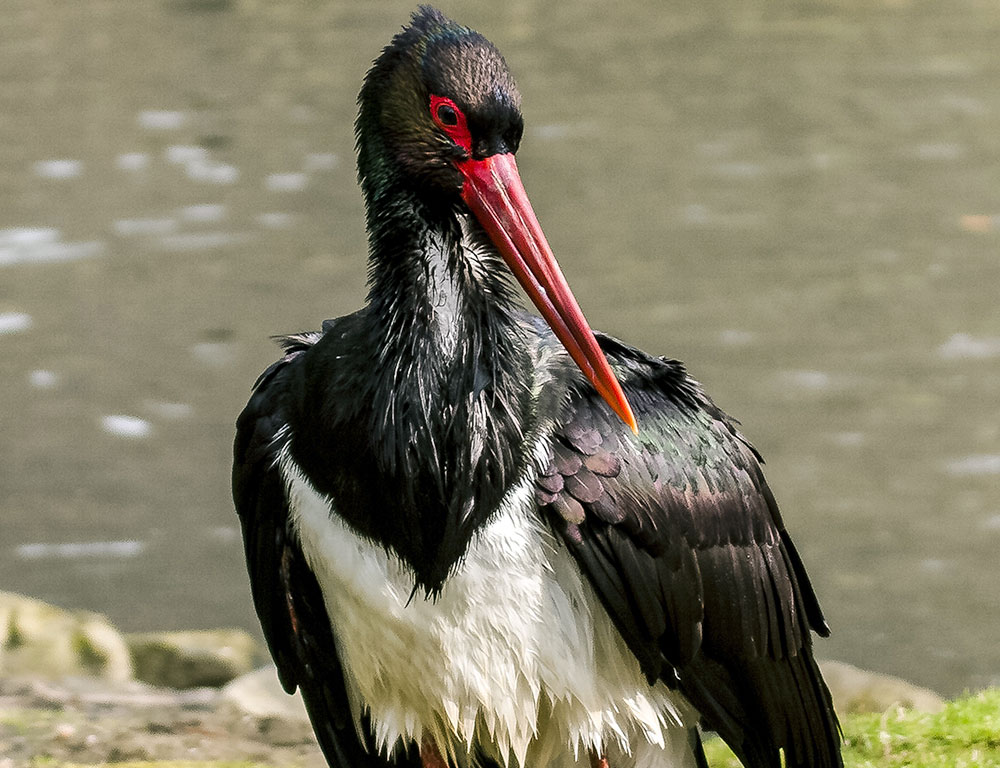
Key Physical Characteristics of the Black Stork
The Black Stork is a striking bird characterized by several key physical features that distinguish it from other members of the Stork family. From its elegant silhouette to its glossy plumage, the Black Stork presents a unique blend of beauty and adaptability.
Size and Shape
The Black Stork is a large bird, typically measuring between 95 and 100 centimeters (37 to 39 inches), with a wingspan ranging from 1.95 to 2.5 meters (6.4 to 8.2 feet). Its body is elongated and streamlined, with a long neck that gracefully extends from its shoulders.
When in flight, the Black Stork’s wings form a distinctive “V” shape, providing efficient aerodynamics for long-distance travel.
Plumage
As its name suggests, the Black Stork is primarily adorned in glossy black plumage, which covers most of its body.
However, this dark hue is not uniform, as subtle iridescent shades of green and purple can be observed under certain lighting conditions.
One notable exception to the bird’s black coloring is its belly, which is typically white. This stark contrast between the dark upper body and the white underbelly creates a striking visual contrast.
Head and Bill
The head of the Black Stork is relatively small in proportion to its body, featuring a pointed, slightly curved bill.
The bill is long and slender, perfectly adapted for capturing and manipulating prey items such as fish, amphibians, and small mammals.
Its sharp tip enables precise probing into the water or soil to locate hidden prey. The coloration of the bill varies from dark gray to black, complementing the bird’s overall appearance.
Legs and Feet
The legs of the Black Stork are long and slender, providing stability while wading through shallow waters in search of food.
Its feet are large and equipped with sharp claws, ideal for grasping slippery prey and maintaining balance on various surfaces.
Unlike some other stork species, the Black Stork does not possess webbed feet, reflecting its preference for terrestrial habitats in addition to aquatic environments.
Tail and Wings
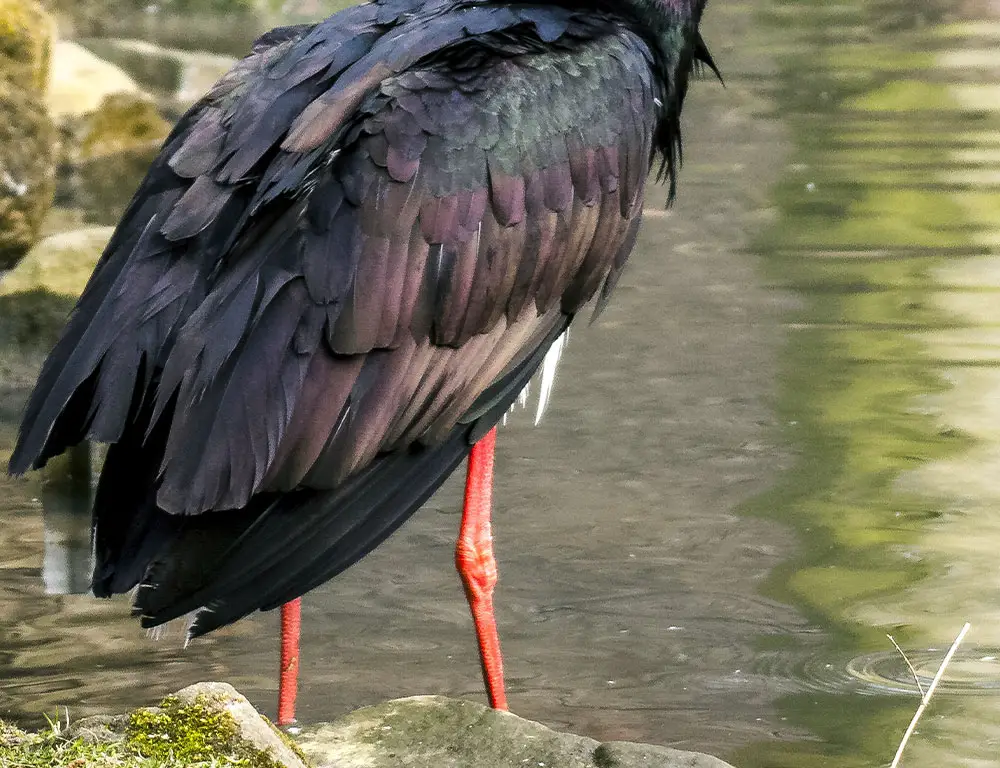
The tail of the Black Stork is relatively short compared to its overall body length, with rounded tips on the tail feathers.
During flight, the bird’s wings exhibit a distinctive pattern of black and white feathers, visible along the trailing edges.
These contrasting colors serve both ornamental and functional purposes, aiding in species recognition and contributing to the stork’s aerodynamic efficiency.
Sexual Dimorphism
Like many bird species, the Black Stork exhibits subtle differences between males and females, known as sexual dimorphism. In this species, males are typically slightly larger and heavier than females, with broader bills and thicker necks.
However, these differences can be challenging to discern without close observation, especially in the wild where individuals may vary in size due to environmental factors and nutritional status.
Juvenile Plumage
Juvenile Black Storks undergo a period of maturation during which their plumage gradually transitions from duller shades of brown to the glossy black coloring of adults.
This process can take several years, with young birds acquiring adult-like plumage by the time they reach sexual maturity.
During this transitional phase, juvenile birds may exhibit a mottled appearance, blending immature and adult plumage elements.
A Deeper Look into the Life History of the Black Stork
The life history of the Black Stork (Ciconia nigra) unfolds as a tapestry woven with intricate behaviors and adaptations.
From its taxonomy to its nesting habits and breeding behaviors, this enigmatic bird offers a glimpse into the complex dynamics of avian ecology and evolution.
Taxonomy
| Taxonomy Level | Classification |
| Kingdom | Animalia |
| Phylum | Chordata |
| Class | Aves |
| Order | Ciconiiformes |
| Family | Ciconiidae |
| Genus | Ciconia |
| Species | Ciconia nigra |
Food Habitat
The Black Stork is primarily carnivorous, with a diet consisting mainly of fish, amphibians, small mammals, and insects. Its foraging habitat includes various aquatic environments such as rivers, streams, marshes, and wetlands.
Additionally, the Black Stork may also forage in terrestrial habitats such as grasslands and agricultural fields, where it preys on insects and small mammals.
Nesting
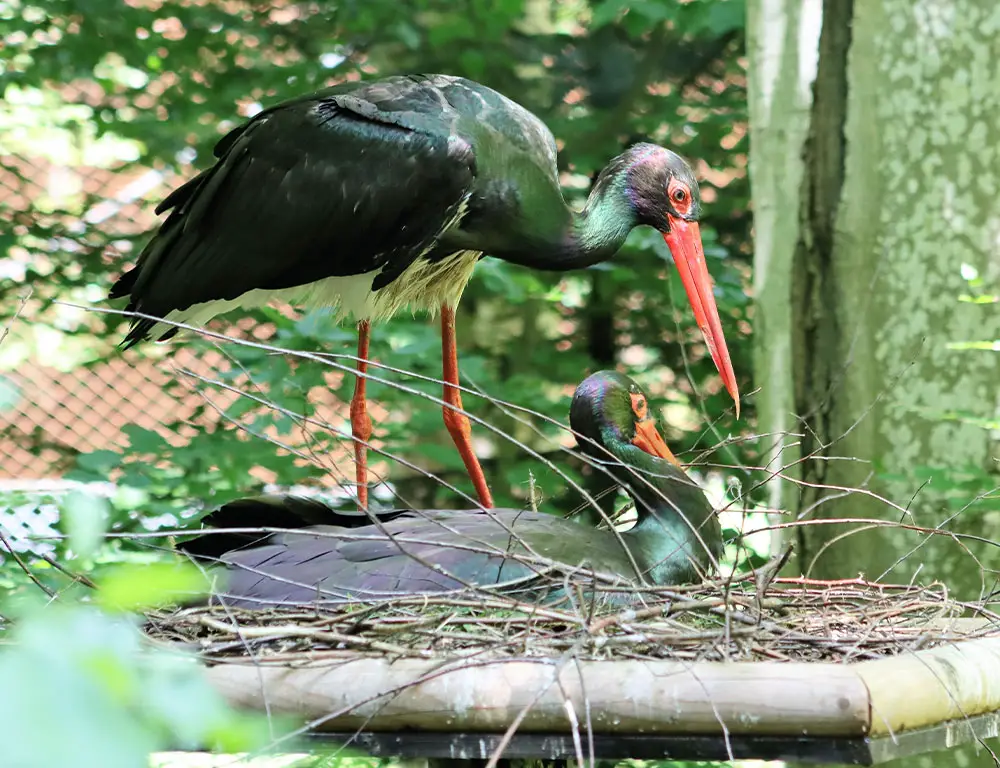
| Nesting Habit | Description |
| Nest Location | Typically built in tall trees or cliffs near water bodies. |
| Nest Structure | Large stick nests lined with softer materials such as moss, grass, and leaves. |
| Nest Building | Both males and females participate in nest construction, with the males often gathering materials and the females arranging them. |
| Nesting Season | Both parents share incubation duties, with the male guarding the nest while the female foraging for food. |
| Clutch Size | Typically lays 2-5 eggs per clutch, with incubation lasting around 4-5 weeks. |
| Incubation and Care | Chicks hatch after approximately one month of incubation and fledge around 8-10 weeks of age, becoming independent shortly after that. |
| Fledging and Growth | Chicks hatch after approximately one month of incubation and fledge around 8-10 weeks of age, becoming independent shortly thereafter. |
Breeding
The breeding season for Black Storks typically begins in early spring, with pairs engaging in elaborate courtship displays to strengthen pair bonds. Once a pair has formed, they select a suitable nesting site and begin constructing their nest.
After the female lays her eggs, both parents take turns incubating them until they hatch. Upon hatching, the parents diligently care for their offspring, providing them with food and protection until they are ready to fledge and become independent.
Migration
Black Storks are migratory birds, embarking on long-distance journeys between breeding and wintering grounds.
In the autumn, they undertake southward migrations to warmer African regions, where they spend the winter months.
These migrations require careful navigation across vast distances, often following well-established flyways and utilizing thermal updrafts to conserve energy during flight.
Range Map
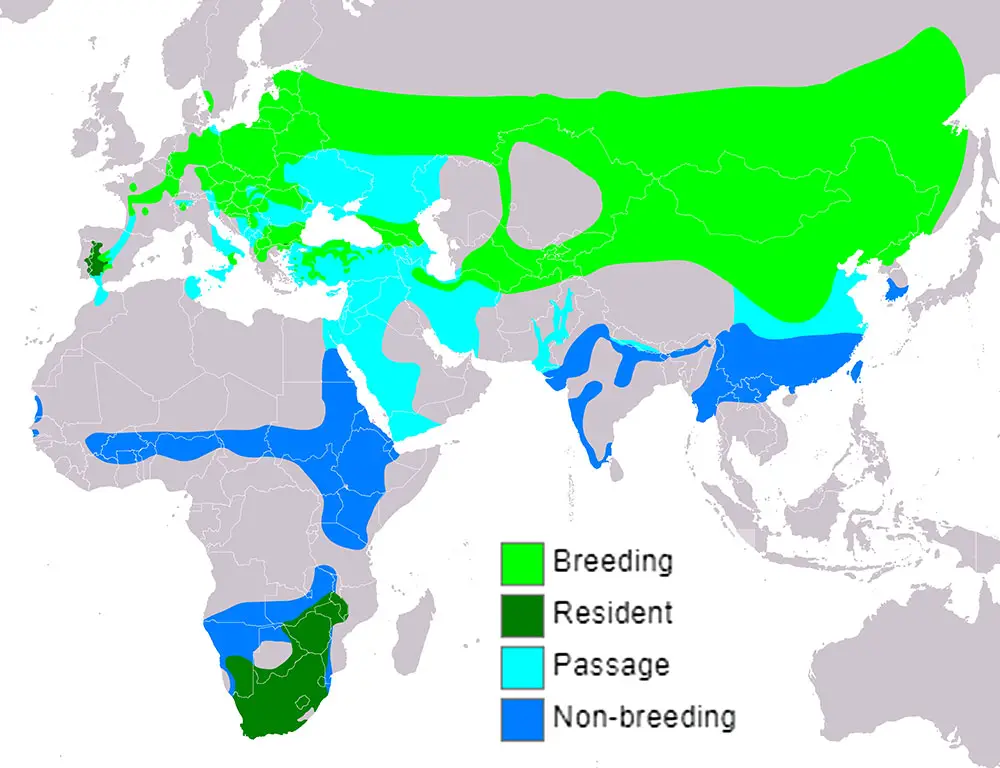
The Black Stork is distributed across a wide geographic range encompassing Europe, Asia, and parts of Africa.
In Europe, its range extends from the Iberian Peninsula in the west to the Ural Mountains in the east. It is also found in Scandinavia, the Balkans, and the Caucasus.
In Asia, the Black Stork inhabits various countries including Russia, China, Mongolia, and Iran. Additionally, it occurs in several countries in northern Africa, such as Morocco, Algeria, and Tunisia.
The range map illustrates the breeding distribution of the Black Stork during the summer months, highlighting key breeding areas and migration routes.
It also indicates areas where the species is known to occur as a resident or non-breeding visitor during other times of the year.
Conservation Status
The conservation status of the Black Stork varies across its range, with regional populations facing different levels of threat and conservation concern.
Overall, the species is evaluated as “Least Concern” by the International Union for Conservation of Nature (IUCN).
However, specific populations are considered vulnerable or endangered due to habitat loss, degradation, and human disturbance.
Conservation efforts focused on habitat protection, restoration, and mitigating human impacts are essential for ensuring the long-term survival of the Black Stork.
Monitoring population trends, conducting research on breeding biology and migratory behavior, and implementing conservation measures at both local and international levels are critical for safeguarding this majestic bird species for future generations.
What Are the Common Diseases and Treatments of the Black Stork?
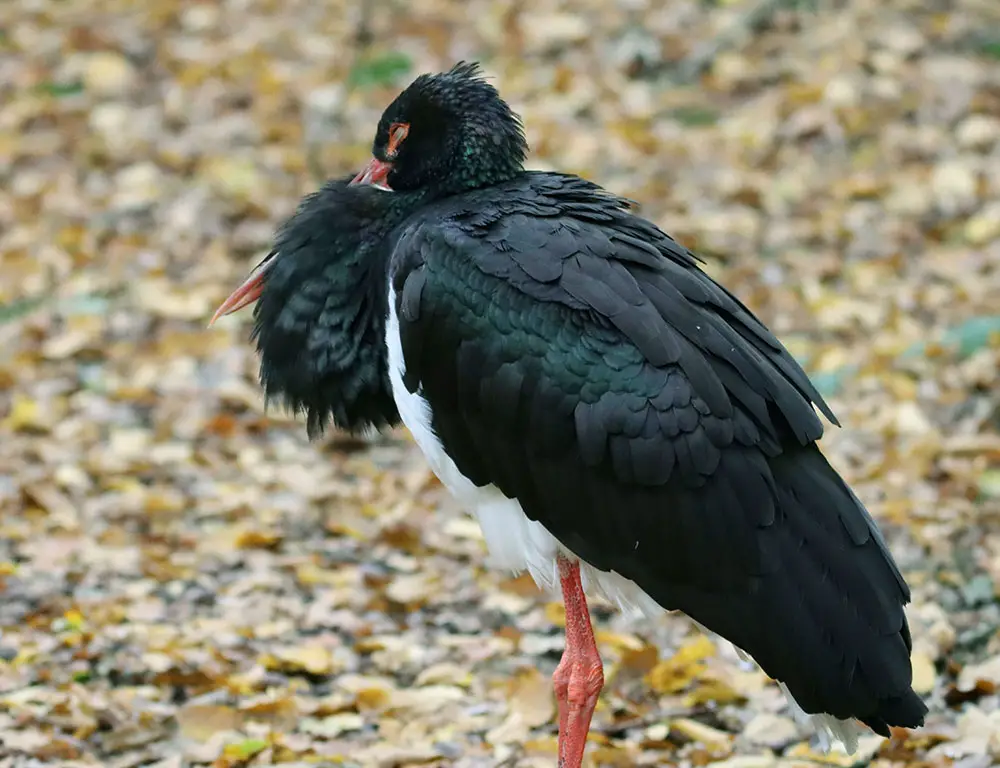
Like all bird species, the Black Stork can be susceptible to various diseases and health issues. Some common diseases that may affect Black Storks include:
Avian Botulism
Avian botulism is caused by the ingestion of the bacterium Clostridium botulinum, which produces toxins that affect the nervous system. Symptoms include weakness, paralysis, and difficulty breathing.
Treatment involves supportive care, such as fluid therapy and nutritional support, along with the administration of antitoxins if available.
Aspergillosis
Aspergillosis is a fungal infection caused by the Aspergillus species, commonly found in decaying organic matter. In birds, it primarily affects the respiratory system, leading to symptoms such as difficulty breathing, lethargy, and loss of appetite.
Treatment typically involves antifungal medications and supportive care to improve respiratory function.
West Nile Virus
West Nile virus is a mosquito-borne disease that can affect birds, including Black Storks. Symptoms may vary, including fever, weakness, and neurological signs such as tremors or paralysis.
There is no specific treatment for West Nile virus in birds, so supportive care and monitoring for complications are essential.
Lead Poisoning
Lead poisoning can occur in birds that ingest lead-containing materials, such as lead fishing weights or contaminated prey. Symptoms may include weakness, lethargy, and neurological signs.
Treatment involves chelation therapy to remove lead from the bird’s system and supportive care to address any complications.
Traumatic Injuries
Traumatic injuries, such as fractures or wounds from collisions with vehicles or structures, can occur in Black Storks. Treatment may involve surgical intervention to repair fractures, wound management to prevent infection, and supportive care to aid healing.
5 Fun Facts About the Black Stork
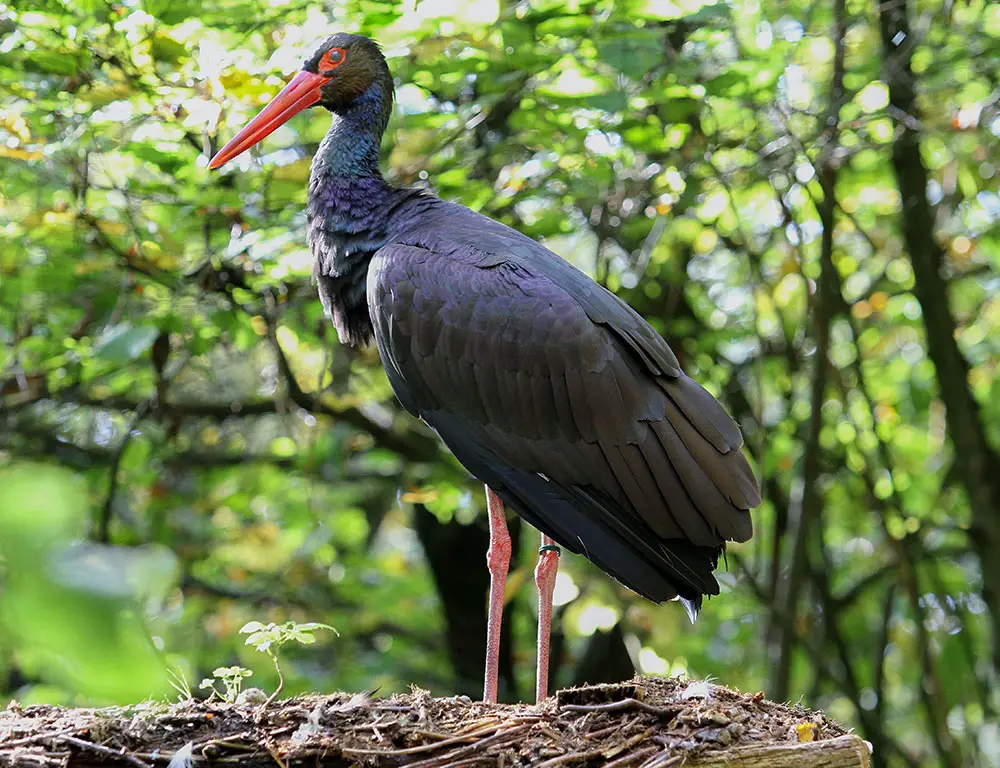
Want to know about the Black Stork more? Here are some fun facts:
1. Mysterious Migration
Despite being a migratory bird, the exact migration routes of the Black Stork remain largely mysterious.
Researchers have only recently begun using satellite tracking technology to uncover the secrets of their long-distance journeys, revealing surprising routes and stopover locations.
2. Social Nesting
Black Storks often exhibit social nesting behavior, with multiple pairs building their nests close to each other in trees or on cliffs. This communal nesting strategy provides benefits such as increased protection from predators and improved foraging opportunities.
3. Innovative Foraging
While Black Storks are known for their preference for aquatic prey, they are also adept at exploiting alternative food sources.
In urban environments, they have been observed scavenging for food at garbage dumps and fish farms, showcasing their adaptability to human-altered landscapes.
4. Silent Hunters
Black Storks are relatively quiet birds, unlike some other stork species, relying less on vocalizations for communication.
Instead, they employ stealthy hunting techniques, patiently stalking their prey before striking swiftly.
5. Cultural Symbolism
Historically, various cultures have revered the Black Stork as a symbol of mystery and elegance.
In ancient Egyptian mythology, it was associated with rebirth and the afterlife, while in European folklore, it often represented omens or portents of change. Today, it continues to inspire awe and fascination as a charismatic ambassador of the natural world.
FAQs
What is the significance of the Black Stork’s black plumage?
The black plumage of the Black Stork serves as both camouflage and thermoregulation. It helps the bird blend into its forested habitat, making it less conspicuous to predators and prey alike.
How does the Black Stork catch its prey?
The Black Stork employs various hunting techniques depending on its prey and habitat. It may wade slowly when hunting in shallow waters, using its sharp bill to probe for fish, amphibians, and crustaceans.
Where does the Black Stork migrate to during the winter months?
During the winter, Black Storks migrate southward to warmer regions in Africa. Their wintering grounds extend across sub-Saharan Africa, where they can find suitable habitats with ample food resources.
How do Black Storks communicate with each other?
While Black Storks are generally quiet birds, they communicate through various vocalizations and visual displays.
During the breeding season, they may engage in bill-clattering and ritualized movements to reinforce pair bonds and establish territories.
Are Black Storks endangered?
The conservation status of Black Storks varies depending on regional populations. While the species is not currently considered globally threatened, specific populations face pressures from habitat loss, pollution, and human disturbance.
Conclusion
The Black Stork emerges as a majestic icon of resilience in the natural world. Through its striking plumage and graceful flight, it captivates both our imagination and our ecological understanding.
As we delve into its history, from nesting behaviors to migratory patterns, we uncover a tapestry woven with intricate adaptations and complex relationships.
Yet, alongside its beauty lies a vulnerability to human-induced threats such as habitat loss and pollution.
It is imperative that we recognize our role as stewards of the environment and take proactive measures to conserve the habitats upon which the Black Stork depends.
By protecting the ecosystems that sustain this symbolic species, we ensure its continued survival and preserve a symbol of wilderness for future generations to admire and cherish.
Let us strive to safeguard the Black Stork, ensuring that its elegant silhouette continues to grace our skies for years to come.